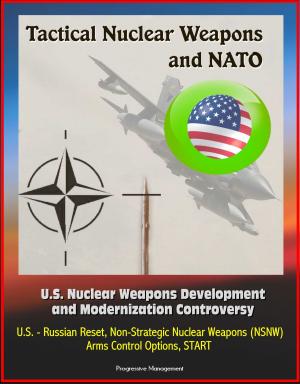The Evolution of U.S. Strategic Command and Control and Warning, 1945-1972: Cold War Nuclear Issues, Soviet Threat, Ballistic Missiles, Custody of Atomic Bombs, Command Posts, DEW, BMEWS
Nonfiction, History, Military, Nuclear Warfare| Author: | Progressive Management | ISBN: | 9781301995004 |
| Publisher: | Progressive Management | Publication: | June 30, 2013 |
| Imprint: | Smashwords Edition | Language: | English |
| Author: | Progressive Management |
| ISBN: | 9781301995004 |
| Publisher: | Progressive Management |
| Publication: | June 30, 2013 |
| Imprint: | Smashwords Edition |
| Language: | English |
This report is a fascinating, candid, and comprehensive review of the controversies and complex issues facing U.S. military and civilian leaders in the Cold War era, from decisions about the custody and control of atomic bombs to the arcane world of MAD, DEFCON, BMEWS, and strategic command and control systems.
The executive summary states: This study is a history of the evolution of US strategic command and control and warning from 1945 to mid-1972. The 27 years under review span the development of US nuclear capability from a small number of atomic bombs and specially modified aircraft to deliver them to the large, complex forces and means to control them that exist currently. Command and control of and warning for US strategic forces have involved the capability to accomplish several basic functions: (1) maintain an up-to-date accounting of the status of forces and nuclear weapons; (2) on the defensive side, secure as early warning as possible of an enemy attack, assess it, and pass that warning to the National Command Authorities and to the strategic forces; (3) communicate the orders to launch strategic forces and maintain contact with them after launch; (4) ascertain the effectiveness of strike forces and the restrike capability of those forces; and (5) maintain the capability to carry out these functions during and after a nuclear attack on the United States. These functions were to become more difficult to perform with the passing years, both as US strategic forces became larger, more diverse, and more sophisticated and as the Soviet nuclear offensive capability grew, US strategic forces moved from sole reliance on piston-engine B-29s to jet aircraft, both land based and carrier based, and then to a combination of jet bombers and land-based missiles. Finally, missile-launching submarines completed the strategic triad. The burdens of command and control in coordinating these elements grew accordingly.
Contents: 1945-1953 * IMPACT OF ATOMIC ENERGY AND THE CONCEPTUAL FRAMEWORK FOR MILITARY EMPLOYMENT * Conceptual Developments: Atomic Blitz * Early Atomic War Plans * CUSTODY OF ATOMIC BOMBS AND AUTHORITY * CONTROL OF ATOMIC OPERATIONS * Organizational Developments. * Targeting Issue * Coordination of Atomic Operations * Impact of Weapons Development on Control Issue
This report is a fascinating, candid, and comprehensive review of the controversies and complex issues facing U.S. military and civilian leaders in the Cold War era, from decisions about the custody and control of atomic bombs to the arcane world of MAD, DEFCON, BMEWS, and strategic command and control systems.
The executive summary states: This study is a history of the evolution of US strategic command and control and warning from 1945 to mid-1972. The 27 years under review span the development of US nuclear capability from a small number of atomic bombs and specially modified aircraft to deliver them to the large, complex forces and means to control them that exist currently. Command and control of and warning for US strategic forces have involved the capability to accomplish several basic functions: (1) maintain an up-to-date accounting of the status of forces and nuclear weapons; (2) on the defensive side, secure as early warning as possible of an enemy attack, assess it, and pass that warning to the National Command Authorities and to the strategic forces; (3) communicate the orders to launch strategic forces and maintain contact with them after launch; (4) ascertain the effectiveness of strike forces and the restrike capability of those forces; and (5) maintain the capability to carry out these functions during and after a nuclear attack on the United States. These functions were to become more difficult to perform with the passing years, both as US strategic forces became larger, more diverse, and more sophisticated and as the Soviet nuclear offensive capability grew, US strategic forces moved from sole reliance on piston-engine B-29s to jet aircraft, both land based and carrier based, and then to a combination of jet bombers and land-based missiles. Finally, missile-launching submarines completed the strategic triad. The burdens of command and control in coordinating these elements grew accordingly.
Contents: 1945-1953 * IMPACT OF ATOMIC ENERGY AND THE CONCEPTUAL FRAMEWORK FOR MILITARY EMPLOYMENT * Conceptual Developments: Atomic Blitz * Early Atomic War Plans * CUSTODY OF ATOMIC BOMBS AND AUTHORITY * CONTROL OF ATOMIC OPERATIONS * Organizational Developments. * Targeting Issue * Coordination of Atomic Operations * Impact of Weapons Development on Control Issue















